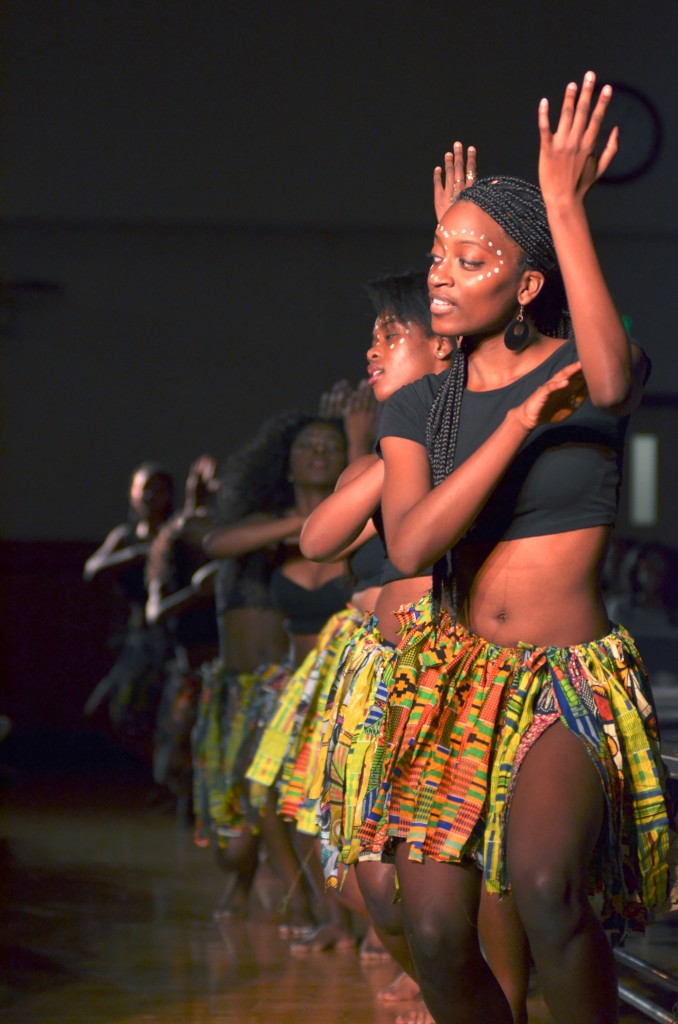
A resounding bass could be heard in the lobby of the Old University Union, as a crowd gathered for Blaq Cinema: The New Classic, a fashion show hosted by the Black Student Union (BSU) for Homecoming Weekend.
BSU’s funds raised from the event were directed toward the Youth Project. BSU invites children ages five to 13 from the Binghamton area to campus once a year for educational classes, activities and a meal. BSU inspires these youth and aims to give back and invest in them as our future. This year, a few of them participated in the show.
The involvement of Youth Project members meets another aim of the show, “to expose young children of color to the successes that their future exudes just like [those of] their older counterparts,” according to Serdal Jasmin, an undeclared sophomore and the social-cultural coordinator for BSU.
The Mandela Room was completely transformed. Cinema projects a “glamorized reflection of life,” Jasmin said, and the decorations extended that to Mandela Room. Elegant, tall tables draped in black tablecloth were placed around the room, each topped with sparkling cider, delicate glasses and silver-star potpourri. One accent wall lit up with red lights, creating a warm, nighttime ambiance. Red and black balloons littered the floor, adding to the festive atmosphere. A roped red carpet marked the entrance to the Mandela Room, dark except for the lit stage. The planning committee, participants and many in the audience wore dresses and suits. This was a fashion show after all.
The audience waited in rows of seats set up in front and around the runway. Doors opened at 7 p.m., but the show didn’t start until 9 p.m. The music and energy of the opening dance set the tone for the whole night and the spirit carried over to the models’ runway walks, which were focused and composed.
Each designer drew inspiration from movies that highlight the successes and contributions of black filmmakers in Hollywood, like “Coming to America,” “School Daze,” “House Party,” “Harlem Nights” and others.
Measurements and pictures of the models were taken and sent to the designers, who aren’t Binghamton students. There were many factors in deciding who wore what. Fit was key.
“For walks with partners, designers tried to match heights to look coordinated,” said Tai Almanzar, an undeclared freshman and one of the show’s 35 models.
Overall, she credits the show for fostering great relationships.
“I encourage people to try out,” Almanzar said. “Best decision we’ve made for making friends and getting out of our rooms.”
The runway walks interspersed with host banter kept the show moving. Sometimes the host and hostess’s chitchat went on for too long and the next acts had to cut them off. For example the, “This is cool and all, but X-fact’r is coming out,” parody of the infamous Kanye interruption to introduce the step team.
The show, while about fashion, was also politically charged. The step team came out chanting, “What do we want? Justice! When do we want it? Now!” The young women on the team protested the “shooting of another young black brother.” Between the team’s step routine, a member shouted, “I don’t think people understand we have structuralized racism, structuralized violence in our country!”
Play fighting about being “too light-skin for this,” was shut down with the reminder to “think of where your brother is, Mike Brown.” At one point, some girls offstage marched in with one hand up, chanting, “Hands up, don’t shoot.”
Though moving performances from poetry readings and chants instilled a serious, thoughtful dimension in the atmosphere, the tone was fun and lighthearted overall. With some striking fashion designs that recall the contribution of black filmmakers in American cinema, the show also recalls the message of many of those movies: While it seems like we’ve progressed, there is still much to do.


